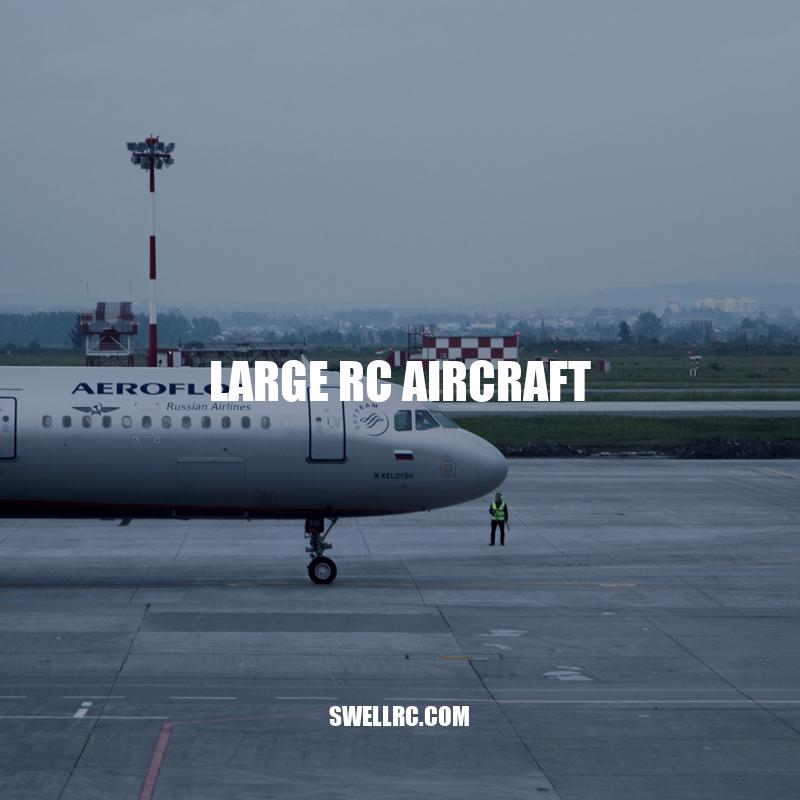Mastering Large RC Aircraft: Tips and Techniques for Flying and Building
Remote controlled (RC) aircraft is an exciting hobby for people of all ages who have an interest in aviation. RC aircrafts can be easily controlled by radio transmission, and come in various sizes and types, from small helicopters to large planes. RC aircrafts have become very popular over time, and many people enjoy building, customizing, and flying these aircrafts. Large RC aircrafts are an advanced type of RC model with a wingspan greater than 8 feet and a weight of up to 55 pounds. They require a lot of effort to build, but the final product is often a masterpiece of engineering. In this article, we will dive into the world of large RC aircrafts, discuss their features, benefits, and challenges, and provide you with tips on how to customize, fly, and maintain these impressive machines.
Types of large RC aircraft
Large RC aircrafts come in different models and types, each with their unique features and specs. Some of the types of large RC aircrafts include:
- Giant Scale Planes: These are large planes with a wingspan of 80-110 inches or more. They are designed to replicate real-life planes and come with advanced features like flaps, retractable gears, and more.
- 3D Aerobatic Planes: These planes are designed to perform advanced aerobatic maneuvers. They have a lightweight, sturdy structure, and large wing area.
- Scale Jets: These are large models of fighter jets and commercial planes, with realistic features like retractable gears, flaps, and other moving parts.
- Gas Turbine Ducted Fans: These planes are powered by a mini gas turbine engine and are typically larger in size. They offer a realistic experience of flying a jet and come with advanced features like realistic sound and smoke effects.
Large RC helicopters are also popular among enthusiasts and come in various types, including scale, flybarless, and coaxial helicopters. Popular manufacturers of large RC aircraft include Hangar 9, E-Flite, and Top Flite. Websites like Horizon Hobby and Motion RC offer a wide range of models, parts, and accessories for large RC aircrafts.
What are the different types of RC planes?
RC planes are a popular hobby and come in a variety of types. Here are a few of the most common types:
| Type | Description |
|---|---|
| Trainers | Designed for beginners, easy to fly and stable. |
| Aerobatic Planes | Designed for advanced maneuvers and stunts. |
| Scale Models | Replicates real-life planes in smaller models. |
| Gliders and Sailplanes | Unpowered planes that use wind currents to stay airborne. |
| FPV Planes | Planes equipped with a first-person-view camera for immersive flying experience. |
For those interested in purchasing an RC Plane or learning more about the different types, websites such as Horizon Hobby, Tower Hobbies and RC Planet offer a range of products and resources.
You are a professional writer that writes engaging, factual and helpful content in English language.
Advantages and challenges
Flying large RC aircraft can be a thrilling and rewarding experience, but it also has some advantages and challenges that need to be considered, including:
- Advantages:
- Increased stability and durability compared to smaller models
- More advanced features and flight capabilities
- Realistic experience of piloting large aircraft
- Challenges:
- Higher cost compared to smaller models
- More difficult to transport and store
- Requires more skill and training to handle
- May require more maintenance and repairs
- May need a larger flying area or permission to fly in certain areas
Interesting fact: The largest RC aircraft in the world is a scale model of the Scaled Composites Stratolaunch, with a wingspan of 38 feet and 2 inches.
It’s important to take safety precautions and follow regulations when flying large RC aircraft. The Academy of Model Aeronautics (AMA) provides guidelines for safe flying, and many local clubs require membership to access their private flying areas. Large RC aircraft enthusiasts can also find helpful resources and support from online forums and communities like RC Groups and RC Universe.
| Advantages | Challenges |
|---|---|
| Increased stability and durability compared to smaller models | Higher cost compared to smaller models |
| More advanced features and flight capabilities | More difficult to transport and store |
| Realistic experience of piloting large aircraft | Requires more skill and training to handle |
| May require more maintenance and repairs | |
| May need a larger flying area or permission to fly in certain areas |
What are the disadvantages of RC planes?
Disadvantages of RC planes include:
- Cost: RC planes can be expensive to purchase, maintain, and repair.
- Learning Curve: Learning how to fly an RC plane takes time and practice, so it can be difficult for beginners.
- Weather Dependent: RC planes are often affected by wind and other weather conditions, making it difficult to fly them in certain conditions.
- Fragility: RC planes are sensitive and prone to damage or crashing, especially if flown by novice pilots.
Despite these challenges, RC planes can be a rewarding and enjoyable hobby for those willing to invest time and effort.
For more information on RC planes or to purchase them, visit websites like Horizon Hobby or RC Planet.
Building and customization
Building and customizing large RC aircraft can be a fun and rewarding process. Here are some considerations when building and customizing your own large RC aircraft:
- Building
- Choose between building from a kit or from scratch
- Research and plan the build process carefully
- Consider the tools and equipment you’ll need
- Be patient and take your time to ensure a quality build
- Customization
- Choose different colors and designs for the exterior
- Add custom decals and graphics for a personalized touch
- Upgrade components like motors, batteries, and servos for better performance
- Add functional features like retractable landing gear or lights
One benefit of building and customizing your own large RC aircraft is the ability to create a completely unique and personalized model. There are many online resources available to help with the process, such as RC Universe and RC Groups forums. Additionally, hobby stores like Horizon Hobby, Tower Hobbies, and HobbyKing offer a wide selection of kits, parts, and accessories for building and customizing RC aircraft.
Can you build your own RC plane?
Yes, you can build your own RC plane. There are plenty of tutorials and resources available online that can help you build one from scratch. Additionally, there are several kits available for purchase that come with everything you need to build an RC plane, including the necessary components and instructions. Some websites that offer RC plane kits include:
Building your own RC plane can be a fun and rewarding experience, but it does require some technical skill and expertise. It’s important to do your research and make sure you have the right tools and materials before starting your project.
When it comes to flying large RC aircraft, there are several techniques and tips to ensure a safe and enjoyable experience. Here are some important considerations:
- Pre-flight
- Check battery levels and ensure they’re fully charged
- Inspect the aircraft for any damage or loose components
- Ensure the control surfaces are properly aligned and functioning
- Flight
- Start with simple maneuvers and gradually build up to more advanced ones
- Avoid crowded areas and seek open spaces to fly
- Keep the aircraft within your line of sight
- Monitor battery levels and land before they get too low
- Regulations
- Be aware of local regulations and guidelines regarding RC aircraft
- Respect the privacy and property of others
- Always obtain permission before flying on private property
It’s important to note that flying large RC aircraft requires practice, skill, and proper training. There are many resources available for learning how to fly safely and effectively, such as the Academy of Model Aeronautics (AMA) and the Remote Pilot 101 online course.
How do you learn to fly RC planes?
To learn how to fly RC planes, you can follow these steps:
- Start with a simulator – this will help you get used to the controls and learn how to fly without crashing your real RC plane.
- Get a beginner-friendly RC plane – look for one with stable flight characteristics and easy-to-use controls.
- Find a local RC club – they can offer guidance, support and training resources.
- Learn the basic maneuvers – practice flying in a straight line, turning left and right, and landing safely.
- Join online RC communities – you can learn from experienced pilots and get advice on how to improve your skills.
- Practice regularly and be patient – flying RC planes takes time to master.
There are also many websites and products that can help you learn, such as RC Plane Masterclass and RC Flight Academy. Some RC plane manufacturers also offer instructional videos and guides on their websites.
Maintenance and repairs
Maintaining and repairing a large RC aircraft is important to ensure its longevity and performance. Here are some tips:
- Cleaning
- Keep the aircraft clean and free of dirt and debris
- Use a soft cloth and mild detergent to clean the exterior
- Never spray water directly onto the aircraft or use harsh chemical cleaners
- Repairs
- Address any damage as soon as possible to prevent further issues
- Refer to the manufacturer’s instructions for proper repair procedures
- Obtain replacement parts from reputable sources such as HobbyKing, Horizon Hobby, and Tower Hobbies
- Storage
- Store the aircraft in a cool, dry place
- Remove the batteries and store them separately
- Cover the aircraft to protect it from dust and debris
It’s important to note that some repairs may require specialized knowledge or equipment. In these cases, it may be necessary to consult with a professional or join a community group for assistance.
There are several resources available for obtaining replacement parts and supplies, such as HobbyKing, Horizon Hobby, and Tower Hobbies. Additionally, many manufacturers offer customer service and repair assistance for their products.
What is the maintenance of an aircraft?
Aircraft maintenance is the process of inspecting, repairing, and servicing an aircraft to ensure its safety and performance. It involves both routine checks and unscheduled repairs. Here are some examples of aircraft maintenance tasks:
- Checking and refueling the aircraft
- Inspecting the engine, brakes, and other critical systems before takeoff and after landing
- Cleaning and maintaining the interior and exterior of the aircraft
- Replacing worn or damaged parts
- Performing periodic overhauls of major systems such as engines and avionics
- Updating software and firmware as necessary
Aircraft maintenance is essential for the safety of passengers and crew. Airlines and aircraft manufacturers have strict regulations and guidelines for aircraft maintenance to ensure compliance with safety standards.
For more information on aircraft maintenance, you can visit websites such as FAA.gov, Airbus.com, and Boeing.com. Additionally, there are products such as maintenance tracking software that can help aircraft owners and operators keep track of maintenance schedules and ensure compliance with regulations.
Conclusion
In conclusion, large RC aircraft are a thrilling hobby that require skill and dedication. They offer many benefits, such as increased stability and durability, but also come with challenges such as higher costs and more difficult handling. However, with proper training, maintenance, and safety precautions, one can greatly enjoy this exciting pastime.
There are many helpful resources available for those interested in RC aircraft, such as online communities, instructional videos, and specialty shops. It’s important to do proper research before purchasing a large RC aircraft, as well as following safety regulations and guidelines when flying.
Whether you’re a seasoned pilot or a beginner, large RC aircraft offer a unique and thrilling experience that is sure to delight. With patience, practice, and a bit of maintenance, you’ll be soaring through the skies in no time.



